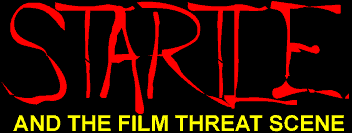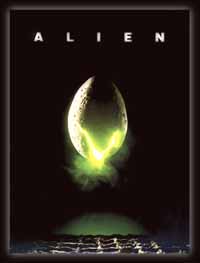|
The sound burst that contributes to this
startle effect is synchronous with the shock cut of Jonesey and
is a symphony of discordant overlapping sound effects: cat
screeches, metal hinge movements, clatter of equipment, actor
exclamations.8 Although
completely telegraphed, and the oldest trick in the book (the
cat-in-the-closet routine parodied by Reiner), the startle is
powerfully affective. The conclusion we can draw, once again, is
that conscious reason and a familiarity with genre conventions
are poor methods for defusing the involuntary startle response
system, a system keyed to momentary disturbances. Indeed,
this cat-in-the-box scene should be no macro surprise coming as
it does as the eleventh threat scene in Alien and as the
eighth startle.
Additional startle scenes from Alien:
Nearly all viewers know that horror and
thriller films might contain startle effects. How, then, can they
be surprised by effects they know are coming? To begin with, the
mind monitors space (primarily extra-consciously) for the
location, identity, and status of nearby objects. Robin Horton
asserts a "primary theory" of human cognition that
transcends culture and is based, in part, on a continual need to
make "two major distinctions . . . between human beings and
other objects; and . . . between self and other."9 There is an obvious utility to monitoring the flux of
proximate objects, of which none are completely stable,
predictable, safe. Location constantly evolves relative to a
perceiver. Identity can change in the most fundamental ways: the
living die; the dead move; the limb becomes a snake, the friend a
murderer. The state of objects is in constant flux: the fixed
breaks away and falls; the tumbling projectile comes to rest;
life rots. Meanwhile, conscious attention is preoccupied with
narrow and new concerns. This is where the cognitive uncanny and
startle come in. These responses remind the conscious mind to
apply itself to what is always potentially more significant: the
consideration of immediate space and its ever-changing objects.
This long-evolving mind, of course, is brought
to film screenings, and, regardless of what we consciously know
about the space before us (whether mimetic or virtual), this mind
functions much as it has done for the last million years. While
watching a threat scene in a film like Alien, viewers
might consciously anticipate the locker opening as a likely
startle moment, but their mind remains concerned, at many levels,
with all manner of imaginary spatial concerns: Will the locker be
empty or contain something? Will the something be dangerous or
benign? If dangerous, what will the threat do to the crew
members? Comparing affectively charged startle effects with
weaker ones exposes how the weaker effects may develop too slowly
to surprise competent, adult viewers. Sticking with the example
at hand, first-time viewers very likely are surprised by the
intensity of the visual and auditory stimulus of the Jonesey
startle. The shots preceding the shock cut of Jonesey range from
30 to 5 seconds--the shock cut is only about 1 second. The
viewer’s overall sense of a scene’s speed is affected
by cutting rate as well as the degree and type of movement of
objects within the frame. In her shock cut, Jonesey is literally
in a frenzy of motion--her movements, for a first-time viewer,
would almost resist coherent cognition, a bit of perceptual
overload accentuated by the extremes of the shot scale: we see
only the head and forepaws of Jonesey.
In the end, there are two differences between
reality- and film-based startles. Although film-based emotional
responses are not "quasi" emotions, conscious reason does
evaluate emotional response contextually, and startles derived
from mimetic space are ultimately judged harmless, with fight and
flight behaviors suppressed. The second major difference between
reality- and film-based startles is that film-based startles rely
on a formalized structure I call the threat scene, where a
character threatened by an offscreen threat is suddenly
confronted in onscreen space by a visual and/or auditory
intrusion. If the staging of such a scene is frightening and its
pacing rapid enough, spectators will respond with true startle. A
threat scene's formal tone ultimately develops out of a
spectator's empathic identification with character and fear of a
depicted threat. Pacing refers to the tempo of the threat scene's
staging and editing and engages each spectator's ongoing
monitoring of space. Failures to fully anticipate significant
changes in one's immediate space (location, identity, status of
objects) whether real or simulated, result in surprise, or, more
radically, in startle.
Why have startle effects become a common
feature of the horror and thriller film genres? The why
question is more difficult and diffuse than how startles
can occur in film spectators. My own conclusion, not at all
original, is that startles prove to us, in the very maw of
virtual death, how very much alive we are. Much like the genres
they are found in, startles engage our primitive
psychophysiologies, and, for the moment, mock our mortality.
Perhaps, too, in revealing what we do not actively control
of our psychology, startle effects reaffirm the animalistic, the
atavistic, and the irrational, expressions the horror and
thriller genres have long exposed beneath decorum, utopianism,
and reason.
page 3 of 3

Go to notes
Robert Baird teaches film and serves as a Multimedia Consultant for
the University of Illinois English Department. He is currently working on a book
entitled How Movies Scare Us: A Cognitive Poetics of the Threat Scene.
|


 A startle effect from Alien reveals how
the threat scene works to establish a tone and pacing potent
enough to trigger startles in viewers. After Kane (John Hurt)
dies from the violent birth of the infant alien, Ripley (Sigourney
Weaver), Parker (Harry Dean Stanton), and Brett (Yaphet Kotto) go
searching for the beast in the massive Nostromo. The
search party carries a light, a large net, a six-foot electric
prod, and a jerry-rigged sensor. The mise-en-scene is classic
dungeon darkness and gothic gloom, the literal bowels of this
massive ore-mining ship. Following the readings from her
motion-tracker, Ripley stops before a row of squat metal lockers.
She whispers to her hunting partners, "Parker, Brett,
it’s in this locker." The three prepare to open the
locker door, and Ripley even gives a countdown: "All right,
Parker, when I say . . . right now."
A startle effect from Alien reveals how
the threat scene works to establish a tone and pacing potent
enough to trigger startles in viewers. After Kane (John Hurt)
dies from the violent birth of the infant alien, Ripley (Sigourney
Weaver), Parker (Harry Dean Stanton), and Brett (Yaphet Kotto) go
searching for the beast in the massive Nostromo. The
search party carries a light, a large net, a six-foot electric
prod, and a jerry-rigged sensor. The mise-en-scene is classic
dungeon darkness and gothic gloom, the literal bowels of this
massive ore-mining ship. Following the readings from her
motion-tracker, Ripley stops before a row of squat metal lockers.
She whispers to her hunting partners, "Parker, Brett,
it’s in this locker." The three prepare to open the
locker door, and Ripley even gives a countdown: "All right,
Parker, when I say . . . right now."





